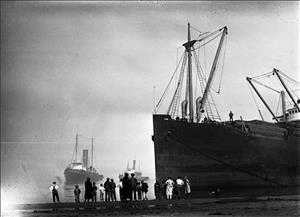On September 3, 1925, the freighter SS Point Judith, en route from Bellingham to Seattle in heavy fog, goes aground on the tide flats off Duwamish Head, part of West Seattle not far from Luna Park. Undamaged, the vessel is floated at high tide with the assistance of the tugboat Sea Monarch, and proceeds to Seattle's Atlantic Street piers to load cargo destined for ports in the Gulf of Mexico.
Headed for the Beach
The SS Point Judith was a 2,670-ton, 289-foot, single-screw, steel-hulled freighter built in 1918 by Albina Engine & Machine Works in Portland, Oregon. The vessel, originally laid down as the SS Carl for Norwegian owners, was requisitioned during World War I (1914-1918) by the United States Shipping Board, Emergency Fleet Corporation, for its Merchant Marine fleet and renamed the USS Point Judith. In 1920, the freighter was sold to the Pacific Mail Steamship Company, and in 1925 to Swayne & Hoyt Ltd., San Francisco, for service in its Gulf-Pacific Line.
Early Thursday morning, September 3, 1925, the freighter SS Point Judith departed the Port of Bellingham en route to the Atlantic Street piers in Seattle to finish loading cargo destined for Tampico, Mexico; Mobile, Alabama; Houston, Texas; and New Orleans, Louisiana. North of Seattle, the captain encountered heavy fog and slowly made his way past the West Point Lighthouse toward Elliott Bay. At some point, likely by dead reckoning, the captain changed course and sailed into the bay.
At 7:00 a.m., the forward progress of the Point Judith came to an abrupt halt. When the fog lifted, the captain discovered the ship had run aground on the tide flats off Duwamish Head near Luna Park. Immediate efforts to back the Point Judith into deep water proved unsuccessful. The vessel, with a 19-foot draft, was stuck in mud and sand some 60 feet off shore, with an outgoing tide.
To Float Again
The captain radioed the Gulf-Pacific Line agent in Seattle, A. M. Gillespie, Inc., and reported his predicament. He said the Point Judith was not in distress and an inspection of the hull revealed the ship appeared to be undamaged. The ship could likely be freed from the tide flats on the afternoon high tide. Meanwhile, scores of spectators journeyed to West Seattle by ferryboat and streetcar to marvel at the beached freighter and watch the upcoming show.
High tide was due to occur between 2:00 and 3:00 p.m. The Gulf-Pacific Line agent contracted with Cary-Davis Tug & Barge Company to have tugboats Sea Monarch and Chehalis standing by to help drag the Point Judith from the mud. The Sea Monarch attached a towing hawser and by 4:30 p.m., the vessel had been floated. The Point Judith proceeded to the Atlantic Street piers where she completed loading her Puget Sound cargo. At 5:00 p.m., Friday, September 4, 1925, the freighter sailed for San Francisco and Los Angeles to load additional cargo for Gulf of Mexico ports.
The Vessels
The 140-foot steam tugboat Sea Monarch was built in Seattle in 1921 for the Shipowners & Merchants Tugboat Company of San Francisco for their Red Stack Fleet. The vessel, one of the most powerful ocean tugs on the West Coast at the time, was chartered to Cary-Davis Tug & Barge Company in Seattle in 1924. The Sea Monarch sank on October 9, 1925, following a collision with the French steamship Zenon in heavy fog off Marrowstone Point without loss of life. And shortly thereafter, the Chehalis was wrecked on North Reef off the coast of British Columbia and sold to salvager L. B. Noel of Victoria.
In 1929, the Point Judith was sold to the McCormick Steamship Company, San Francisco, and renamed the Charles L. Wheeler, Jr. for the son of the vice president and general manager of the company. The vessel made maritime history in 1938 when she sailed 200 miles up the Columbia River, through the locks of Bonneville Dam, to the historic steamboat port of The Dalles, marking the city's potential as a deep-water ocean port. The voyage was essentially a publicity stunt to demonstrate that deep-water vessels could utilize the Columbia River to deliver cargo directly to ports in eastern Washington and Oregon.
In 1948 the Wheeler was scrapped at the Puget Sound Bridge & Dredging Company yard in Seattle.

